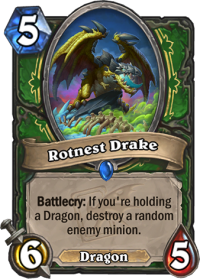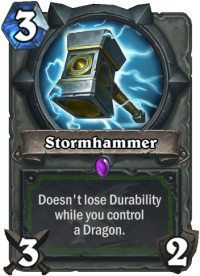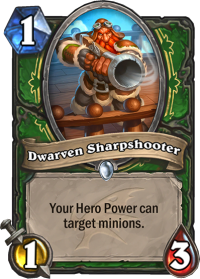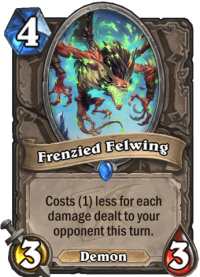Our Dragon Hunter deck list guide goes through the ins-and-outs of this aggressive Hunter deck that came to life with the Galakrond’s Awakening adventure! This guide will teach you how to mulligan, pilot, and substitute cards for this archetype!
Introduction to Dragon Hunter

Hunter has a long history of aggressive strategies, but dragons have usually not been a part of them. Dragon Hunter used to be an attempt at slow midrange or control strategies that are generally ill-suited for Hunter’s natural ability to deal face damage. This all changed with the Galakrond’s Awakening adventure that introduced Rotnest Drake to the game. Descent of Dragons had already added a large number of dragon synergy cards to the game, including the phenomenal Stormhammer, but until Rotnest Drake, Hunter lacked the critical mass of aggressive dragon cards to really bring an aggressive Dragon Hunter deck to the meta.
Well, now it’s here. Dragon Hunter is a powerful aggressive Hunter deck that focuses on dragon synergies to control the board while dealing damage to the opponent’s Hero. Corrosive Breath damages a minion and deals face damage at the same time, Stormhammer has infinite charges for board control or just face damage as long you can keep a dragon alive, and Faerie Dragon and Evasive Feywing are difficult to deal with because they cannot be targeted by spells or Hero Powers. Rotnest Drake adds a big mid-game minion with a built-in free Deadly Shot to the mix. All of this combines to form an aggressive deck that can also control the board in the early game just enough to push through before the opponent can get things under control.
Dragon Hunter Deck List
- 0Dragon Hunter Deck List Guide – Galakrond’s Awakening – March 20201
- 0Dragon Hunter Deck List Guide – Galakrond’s Awakening – March 20201
- 0Dragon Hunter Deck List Guide – Galakrond’s Awakening – March 20201
- 0Dragon Hunter Deck List Guide – Galakrond’s Awakening – March 20201
- 0Dragon Hunter Deck List Guide – Galakrond’s Awakening – March 20202
- 0Dragon Hunter Deck List Guide – Galakrond’s Awakening – March 20202
- 1Dwarven Sharpshooter2

- 2Corrosive Breath2

- 2Phase Stalker2

- 3Primordial Explorer2

- 3Stormhammer2

- 5Rotnest Drake2

Check out alternative versions of this deck on our Dragon Hunter archetype page!
Dragon Hunter Mulligan Strategy & Guide
VS Fast Decks
Higher Priority (Keep every time)
- Stormhammer – This weapon can just do it all. Control the board or hit face, it goes wherever it is needed.
- Blazing Battlemage – Great one-drop in every matchup. Able to pose a threat or trade effectively.
- Dwarven Sharpshooter – Not much of a threat, but board control can win aggro mirrors and Sharpshooter can help you gain that.
- Phase Stalker – Decent stats and draws and plays Secrets from your deck. Always useful.
Lower Priority (Keep only if certain conditions are met)
- Faerie Dragon – Keep against Rogue, as they have a hard time dealing with minions that cannot be targeted by spells.
VS Slow Decks
Higher Priority (Keep every time)
- Stormhammer – This weapon can just do it all. Control the board or hit face, it goes wherever it is needed.
- Blazing Battlemage – Great one-drop in every matchup. Able to pose a threat or trade effectively.
- Phase Stalker – Decent stats and draws and plays Secrets from your deck. Always useful.
Lower Priority (Keep only if certain conditions are met)
- Frenzied Felwing – Keep with good early-game minions, especially Blazing Battlemage.
Dragon Hunter Play Strategy
The main strength of Dragon Hunter is its ability to destroy minions while keeping up the pressure. It is not a deck that wants to play a long game, but it is not a pure face deck either. It is an aggro deck that is interested in the board as far as it can keep dealing damage at the same time as it controls the board. With tools such as Corrosive Breath, Stormhammer, Scalerider, Dragonbane, and Rotnest Drake, you can maintain board control almost for free in the early turns. Later in the game, you will not be able to maintain control, so it is important to deal enough damage to be able to wrap things up in the mid-game.

Be mindful of your dragons. Stormhammer requires you to have a dragon on board for additional charges, while Scalerider, Corrosive Breath, and Rotnest Drake require a dragon in hand for their effects. Try your best to balance between the two demands and always have a plan for having dragons in hand. Sometimes you want to play them all to push, but sometimes you need to hold one back to be able to activate the right topdeck.
The basic use of Phase Stalker is to play it when you have four mana available so that you can use your Hero Power to draw and play a Secret immediately. However, sometimes you need to take the chance with it and play it out early: if it goes unanswered, you are in a good position to run away with the game. Evaluate the resources you have available and the removal capabilities of your opponent, and take chances when you do not have an alternative line of play that gets you off to a good start. The same line of thinking applies to Dragonbane: while playing it when you are at six mana is safe, sometimes playing it when you are at four is the right move to enable you to snowball to victory.
If you have an early Frenzied Felwing, try to figure out the best way to deal four damage in a turn to make it free. Sometimes the answer is as easy as a Blazing Battlemage. Sometimes the answer is to coin out a Faerie Dragon that can be difficult for the opponent to remove.
If you have a Rotnest Drake in hand, you sometimes want to prepare the board for it. This can mean trading away tokens so that you can get the effect on the right target. This only applies to opponents who do not flood the board: against something like a Zoo Warlock, you can never set up the perfect Rotnest Drake anyway, so you should not worry about it too much.
Be prepared for taunt minions. Rotnest Drake can be a great answer, but sometimes you also want to consider the possibility that your minions will not be able to hit face again. Corrosive Breath, Scalerider, and Dragonbane can give you reach even through taunt minions. Consider whether saving them for a final push is more effective than using them immediately.
Try to weave in your Hero Power whenever possible. Sometimes this even means using your coin just to use your Hero Power! (No, not on turn one, that is just wrong.) Sure, Phase Stalker + coin + Hero Power is a classic, but there are also games where you still have the coin a couple of turns later and by using the coin you get in an extra Hero Power without weakening your next turn.
VS Aggro Decks

You are decent, but not great, at racing other aggro decks. Because you have so many board control tools, it is always worth considering whether the way to win is through board control on the first turns followed up by an intense push to face in the mid-game. If you face something like a Zoo Warlock, for example, allowing them to build a board can result in a buffed-up board and Sea Giants, and then you will have a hard time racing against that.
Always consider what removing minions from the opponent will mean for the clock of each player: how many turns will it take for each of you to die. Removing minions from the opponent results in less damage to you, but also in less immediate damage to the opponent. Go for early board control against decks that can snowball if they gain the board, race the decks that cannot. Dwarven Sharpshooter can be a great tool for controlling the board against other aggressive decks.
Whether you control the board or not also depends on your hand. Have an early Frenzied Felwing? Perhaps it is time to just push face damage and get more minions on the board, and leave trading for the opponent.
VS Control Decks

You have a clear window of opportunity to win the game. Push hard and play around their main removal pieces. For example, try to set up boards that do not completely wipe to a Mass Hysteria against Priest: sometimes even playing an additional 1/3 on the board means that your biggest minion can die, whereas not playing it will leave the board unable to be wiped. Likewise, consider what Reno the Relicologist can do to your board against Mage: can you get more than 10 health on the board to play around that? In such a situation, an additional 1/3 body can make all the difference to protect your board.
Faerie Dragon and Evasive Feywing are often powerful against control decks (and Rogue!) because they cannot be removed with targetable spells. They can be especially useful to keep your Stormhammer charges up so that you can push damage in with that turn after turn.
Frenzied Felwing is great in control matchups. If you can cheat it out early, you can cruise to victory before the control deck can respond.
Dragon Hunter Card Substitutions
Dragon Hunter is a fairly affordable deck overall, and there are some changes you can make to bring its cost further down. Unfortunately, the Galakrond’s Awakening adventure is almost mandatory for the deck because Rotnest Drake is a signature card for the archetype that cannot be replaced effectively.
- Leeroy Jenkins is a great Legendary minion for all aggressive decks, but in this case, there is an effective replacement available in the form of Lifedrinker.
- Dragonbane is a powerful aggressive tool, but it too can be replaced with another Lifedrinker.
- Snake Trap is by no means mandatory. Making changes to your Secret package can be an effective way to remain surprising. Explosive Trap is an option if you face a lot of board-centric aggro decks and Freezing Trap is great against decks that do not flood the board.
- Stormhammer is the best card in the deck. You can try Eaglehorn Bow instead, but you really do not want to replace this card.
- If you really have to play the archetype without the adventure cards, you can try to replace Rotnest Drakes with Evasive Wyrms and Frenzied Felwings with Animal Companions.





